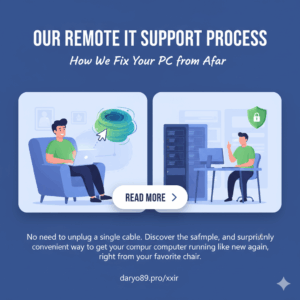Your Digital Handshake: How a Professional Website Fuels Client Acquisition for Freelancers and Small Businesses
For freelancers and small business owners, the hunt for new clients is relentless. It’s the engine that drives growth and sustainability. While referrals, social media buzz, and freelance marketplaces play a role, relying solely on these channels often leads to inconsistent income and intense competition. In today’s digital-first landscape, there’s a more powerful, reliable ally in your quest for clients: your professional website.
Think of your website as far more than just an online brochure or a digital business card. It’s the cornerstone of a modern client acquisition strategy. It’s your virtual storefront, your 24/7 sales representative, and your primary platform for building trust and showcasing value. In an era where potential clients conduct thorough online research before making decisions, having a high-quality website isn’t a luxury—it’s a fundamental necessity. A staggering 31% of US shoppers reported actively choosing not to engage with a small business simply because it lacked a website. Furthermore, your competitors likely already have established websites, putting you at an immediate disadvantage if you don’t.
This article will explore precisely how a professional website acts as your most potent tool for attracting, engaging, and converting prospects into loyal clients. We’ll delve into its role in establishing credibility, showcasing expertise, generating leads directly, standing out from the competition, and why factors like design and speed are critical for success.
It’s crucial to understand that the absence of a website isn’t neutral; it actively sends negative signals to potential clients. When prospects can’t find a dedicated online presence, it raises questions about the business’s legitimacy, seriousness, professionalism, and even its longevity. They perform due diligence online, compare you against competitors who have invested in a website, and may perceive the lack of this foundational digital asset as a red flag.
Moreover, your website serves as the central, owned hub in your digital marketing ecosystem. Unlike social media profiles or marketplace listings—platforms you essentially rent—your website is digital real estate you control. All your other marketing efforts, from social media posts and email campaigns to paid ads, should ideally drive traffic back to this central hub. This allows you to control the user journey, optimize for conversions, maintain consistent branding, gather valuable data about visitor behavior, and operate independently of third-party platform algorithms, rules, fees, and rampant competition. Owning your website provides stability and strategic control over your client acquisition pipeline.
Your Digital First Impression: Building Trust and Credibility Instantly
In the online realm, your website serves as the initial handshake and the first glimpse into your business’s character. Potential clients form opinions incredibly quickly – often within fractions of a second (0.05s to 0.5s). A professional, well-designed website immediately signals legitimacy, seriousness, and competence, laying the groundwork for trust. Conversely, a poor first impression can deter visitors permanently.
Several factors contribute to this crucial first impression:
- Credibility Builders: A modern, functional, and aesthetically pleasing website is paramount. Key pages play vital roles:
- An engaging ‘About Us’ page humanizes your brand, sharing your story, mission, and the people behind the business. This is often one of the most visited pages as clients seek connection.
- Clear and easily accessible contact information (physical address if applicable, phone number, professional domain-based email, business hours) assures visitors they can reach you.
- Credibility Killers: The most obvious killer is the complete lack of a website. Beyond that, a poorly designed, outdated, or broken website severely damages credibility. Using generic email addresses (like @gmail.com or @yahoo.com) instead of a professional one linked to your domain (e.g., contact@yourbusiness.com) can also make a business look less established or even “shady” and unable to manage basic IT.
The Power of Social Proof:
In the absence of a face-to-face meeting, potential clients rely heavily on social proof to gauge your reliability and effectiveness. Testimonials, client reviews, detailed case studies, and logos of past clients are not just nice-to-haves; they are essential trust-building elements. Prospects actively seek this validation; studies show 99.9% of customers read reviews during online shopping. Including authentic details like the client’s name and photo alongside testimonials adds significant weight. Displaying positive reviews can dramatically increase conversion rates, potentially by as much as 270%. A website provides the perfect platform to curate and prominently display this crucial social proof, reinforcing your claims and easing potential client anxieties.
A professional website functions as more than just a credibility signal; it acts as a filter and qualifier. It helps attract clients who appreciate quality and professionalism, potentially deterring those solely focused on the lowest price. High-paying clients often have higher expectations regarding a business’s presentation and established presence. A polished website signals investment and attention to detail, aligning with these expectations. Conversely, a subpar online presence might attract clients seeking bargains, leading to misaligned projects or lower-value engagements. Thus, your website implicitly positions your business within the market.
Furthermore, the trust established upfront through a professional website streamlines the entire client acquisition process. Client acquisition is a journey, often visualized as a funnel. When a prospect arrives at a consultation call or receives a proposal already feeling confident in your abilities due to a positive website experience, there’s less friction. This pre-established trust makes them more receptive, potentially shortening the sales cycle and increasing closing rates because fundamental credibility hurdles have already been cleared. A poor website, however, creates initial skepticism that must be actively overcome in later interactions, adding time, effort, and cost to the acquisition process.
Showcase Your Brilliance: Your 24/7 Portfolio and Expertise Hub
One of the most significant advantages of a dedicated website is its function as a centralized, curated showcase for your work and expertise. Instead of scrambling to send relevant work samples manually or directing prospects to scattered profiles across various platforms, your website serves as a permanent, easily accessible online portfolio. This saves valuable time for both you and potential clients.
To effectively showcase your capabilities, your website portfolio should include:
- High-Quality Visuals: Clear images and videos of your past projects or deliverables.
- Detailed Case Studies: Go beyond just showing the final product. Explain the client’s challenge, your process, the solution you provided, and, most importantly, the measurable results achieved. This demonstrates the value you deliver.
- Clear Service Descriptions: Outline exactly what you offer and who your services are best suited for.
- Client Logos (with permission): Displaying logos of recognizable clients adds instant credibility.
Beyond showcasing completed work, your website is the ideal platform to demonstrate deeper expertise. A blog or resources section allows you to share industry insights, tips, tutorials, and thought leadership pieces. This not only provides value to visitors but also positions you as an authority in your field and significantly boosts your website’s visibility in search engines.
Furthermore, your website offers a unique opportunity to inject personality into your brand. Especially for freelancers and small teams, allowing potential clients to get a sense of the people behind the business through tone of voice, photos, and storytelling can build a stronger connection and differentiate you from larger, more impersonal competitors. Clients want to know who they’re working with, and your website can facilitate that introduction.
Presenting your work through well-documented case studies on your website fundamentally shifts the client conversation from focusing solely on price to understanding the value and results you deliver. While freelance marketplaces often foster a competitive environment based on cost, your own website allows you to control the narrative. By highlighting successful projects with tangible outcomes, you demonstrate the potential return on investment for the client. This approach justifies potentially higher rates and attracts clients who are seeking effective solutions and measurable results, rather than simply the cheapest option available.
Moreover, a consistently updated portfolio and blog signal that your business is active, relevant, and continuously evolving. A website with outdated projects or an inactive blog might suggest stagnation or a lack of engagement with current industry trends. Regularly adding fresh content—new case studies, recent blog posts discussing current topics—demonstrates ongoing expertise and reassures potential clients that you are actively working and capable of delivering modern, effective solutions. This perception of vitality builds confidence and makes prospects more likely to initiate contact.
The Lead Generation Engine: Turning Clicks into Clients
While building credibility and showcasing work are vital, a professional website’s primary function in client acquisition is to actively generate leads. It shouldn’t just be a passive repository of information; it should be a proactive tool for attracting and capturing potential clients.
Driving Qualified Traffic:
Two main avenues drive potential clients to your website:
- Search Engine Optimization (SEO): By optimizing your website’s content, structure, and technical aspects for relevant keywords that potential clients are searching for (e.g., “graphic designer for startups,” “local plumber emergency service”), you can attract organic traffic from search engines like Google. Appearing high in search results for these terms puts your business directly in front of people actively seeking your services. This is a powerful way to diversify your client sources beyond referrals or marketplaces.
- Referral Traffic: Your website serves as the essential destination for traffic directed from various other marketing channels. Whether it’s a link in your social media bio, a button in an email newsletter, a click on a paid advertisement, or even someone you met at a networking event asking, “Could I take a look at your website?”, all roads should lead back to your central online hub.
Capturing Interested Leads:
Once visitors arrive, your website needs mechanisms to convert their interest into actionable leads:
- Clear Calls to Action (CTAs): Every page should guide the visitor toward the next logical step. Use clear, action-oriented buttons or links like “Request a Free Quote,” “Schedule a Consultation,” “Download Our Guide,” or “Contact Us Today.” These should be strategically placed and visually prominent. Shockingly, studies suggest 70% of small business websites lack effective CTAs on their homepage. Landing pages with a single, focused CTA often perform best.
- Optimized Contact Forms: Make it effortless for prospects to reach out. Include easy-to-find contact forms. Keep forms concise, asking only for essential information, as overly long forms can deter users. Forms with five or fewer fields tend to see higher conversion rates.
- Targeted Landing Pages: For specific marketing campaigns or service offerings, create dedicated landing pages. These focused pages remove distractions and are designed purely to convert visitors for that specific goal. Removing the main website navigation from a landing page can sometimes even double its conversion rate.
- Lead Magnets: Offer valuable, downloadable content—such as e-books, checklists, templates, or access to exclusive webinars—in exchange for an email address. This allows you to capture leads who may not be ready to buy immediately but are interested in your expertise.
While average website conversion rates hover around 2-3%, this varies significantly by industry and website quality. Numerous case studies demonstrate substantial increases in lead generation following website redesigns focused on optimization.
Having a website fundamentally shifts your client acquisition from a passive stance (waiting for referrals or marketplace notifications) to a proactive one. By optimizing for SEO, you attract inbound leads from genuinely interested prospects. By strategically employing CTAs and lead magnets, you actively encourage engagement and information exchange. This owned, proactive approach provides far greater stability and predictability compared to relying solely on external, often volatile, channels.
Furthermore, integrating your website with Customer Relationship Management (CRM) systems and marketing automation tools elevates it from a static digital brochure to a dynamic component of your sales process. Capturing a lead is just the first step; nurturing that lead towards conversion is crucial. Connecting website forms to a CRM allows you to track interactions and build a history for each prospect. Marketing automation can then trigger personalized follow-up emails or deliver targeted content based on their website activity. Implementing lead scoring can help prioritize your follow-up efforts on the prospects showing the most engagement. This systematic nurturing significantly boosts the probability of converting captured leads into paying clients.
Don’t Just Compete, Dominate: Standing Out with Your Own Platform
Freelance marketplaces and social media platforms can be useful starting points, but they often come with significant drawbacks: intense competition (sometimes against thousands of others for a single gig), downward pressure on pricing, intermediary fees that cut into your earnings, and restrictive platform rules. Some platforms even face the risk of clients and freelancers bypassing them entirely once trust is established, highlighting their potential limitations as long-term solutions.
Your own website offers a powerful escape from this maze. It provides complete autonomy and control, allowing you to:
- Own Your Brand Identity: A unique website gives you full control over your branding, messaging, design, and overall user experience. You dictate how your business is perceived, crafting a distinct identity that resonates with your ideal clients, rather than fitting into a generic platform profile.
- Differentiate Yourself: In a crowded market, standing out is key. Your website is your canvas to showcase what makes you unique – your specific expertise, your approach, your personality, your success stories. This differentiation helps attract clients looking for your specific value proposition.
- Command Higher Rates: By establishing a strong, professional brand presence and demonstrating value through your website (via compelling case studies and expert content), you move away from price-based competition and gain the leverage to set higher rates that reflect your expertise. Clients seeking quality and specific solutions are often willing to pay more for a provider who clearly demonstrates their worth online.
- Expand Your Reach Strategically: A website unlocks a multitude of client acquisition channels beyond marketplaces. You can leverage SEO, content marketing, paid advertising (Google Ads, social media ads), email marketing, and strategic partnerships, all directing qualified traffic back to your owned digital property.
Investing time and resources into building and optimizing your own website directly builds long-term business equity—a valuable asset you own. Efforts spent solely on enhancing your profile or generating reviews on third-party platforms primarily benefit the platform itself; that value can be diminished or lost if the platform changes its rules, increases fees, or if you decide to leave. A well-ranked, reputable website is a durable asset that provides ongoing returns, independent of any single external platform’s trajectory.
Moreover, your website facilitates the building of direct, meaningful relationships with clients. Marketplaces often act as intermediaries, sometimes limiting direct communication or imposing transaction fees. Your website, through contact forms, email newsletter sign-ups, integrated chat features, and the content you share, opens a direct channel for communication. This allows for personalized interaction, effective lead nurturing, and the fostering of client loyalty, leading to potentially longer-term engagements, repeat business, and valuable referrals—outcomes often harder to achieve through the inherently transactional nature of many online platforms.
Design, Experience, and Speed: The Conversion Accelerators
Simply having a website isn’t enough; it needs to be effective. A poorly constructed website – one that’s slow, difficult to navigate, visually unappealing, or not mobile-friendly – can actually be more detrimental than having no website at all. Its effectiveness hinges on three interconnected pillars: design, user experience (UX), and technical performance (specifically, speed).
User Experience (UX) is Non-Negotiable:
- Navigation and Layout: Visitors need to find information easily and understand where to go next. Intuitive navigation, a logical site structure (information architecture), and clean, uncluttered layouts are essential for keeping users engaged. Confusing navigation or overwhelming layouts lead to frustration and high bounce rates (users leaving quickly). Studies show 38-39% of users will abandon a site if the layout is unattractive or difficult to follow.
- Visual Appeal and Branding: Professional aesthetics matter. High-quality images and videos, a consistent color palette, readable typography, and a clear brand identity contribute significantly to trust and create a positive initial perception. Remember, 94% of first impressions are design-related, and 38% of users will leave if they find the design unattractive.
- Mobile Optimization: In today’s world, optimizing for mobile devices is absolutely critical. A significant portion of web traffic originates from smartphones and tablets. Websites that don’t adapt seamlessly to smaller screens provide a frustrating experience, leading users to leave. Research indicates 48% of consumers feel frustrated by sites not designed for mobile, and 50% would decrease interaction with a business, even if they like it, if its site isn’t mobile-optimized. A poor mobile experience can even signal to users that the business doesn’t care. Furthermore, mobile conversion rates can decrease by as much as 20% for every second a mobile page takes to load.
The Critical Need for Speed:
Page load speed has a direct and dramatic impact on user behavior and conversion rates. Slow websites kill conversions. Consider these statistics:
- User Expectations: 47% of users expect a webpage to load in 2 seconds or less.
- Impact of Delays:
- Even a one-second delay in page load time can lead to a 7% reduction in conversions.
- Walmart found that for every 1-second improvement in load time, conversions increased by 2%.
- COOK increased conversions by 7% simply by reducing page load time by 0.85 seconds.
- Testing showed pages loading in 2.4 seconds had a 1.9% conversion rate, while those loading at 4.2 seconds converted at less than 1%, and those taking over 5.7 seconds converted at only 0.6%.
- Websites loading in 1 second can achieve conversion rates 2.5 to 3 times higher than those loading in 5 seconds.
- Bounce Rates & SEO: Slow speeds lead to higher bounce rates. As load time increases from 1 to 3 seconds, the probability of a user bouncing increases by 32%. High bounce rates signal a poor user experience to search engines like Google, which can negatively impact your SEO rankings, leading to less visibility and fewer organic leads.
Investing in professional design, intuitive UX, and fast loading speeds is not merely an expense; it’s a direct investment in revenue generation. Poor performance leads to lost opportunities and wasted marketing spend. Conversely, improvements in these areas demonstrably increase conversion rates, leading to a lower cost per acquisition (CAC) and a higher return on investment. The ROI on UX improvements can be exceptionally high, potentially reaching thousands of percent.
Furthermore, the quality of your website experience serves as a powerful proxy for the quality clients can expect from your actual services or products. A slow, buggy, outdated, or confusing website suggests a lack of attention to detail, technical proficiency, or overall professionalism. Potential clients may subconsciously (or consciously) think, “If they can’t even get their own website right, how can I trust them with my project?”. This perception directly impacts their trust and willingness to engage, making excellent website performance and UX critical for attracting discerning clients who value quality.
Conclusion: Stop Leaving Clients on the Table – Invest in Your Website
The evidence is clear: for freelancers and small businesses aiming for sustainable growth, a professional, high-performing website is not just beneficial – it’s essential. It serves as your digital foundation, powerfully influencing client perception and driving acquisition in multiple ways.
Let’s recap the critical roles your website plays:
- Builds Credibility: It establishes legitimacy and trust instantly, acting as your digital handshake in a world where first impressions are formed in seconds.
- Showcases Expertise: It provides the ideal, controlled platform to display your best work, share valuable insights through case studies and blogs, and prove your capabilities.
- Generates Leads: Through SEO, clear calls-to-action, optimized forms, and targeted landing pages, it actively attracts and captures potential clients.
- Differentiates Your Brand: It allows you to escape the competitive noise of marketplaces, own your brand narrative, and stand out to attract higher-value clients.
- Accelerates Conversions: Its design, user experience, and loading speed directly impact whether visitors engage, trust you, and ultimately take action.
The cost of inaction – sticking with an outdated site, a poorly performing one, or having no website at all – is significant. It translates directly to lost leads, damaged credibility, an inability to compete effectively, and ultimately, missed revenue opportunities. Remember, nearly a third of US shoppers have actively avoided small businesses simply due to the lack of a website.
It’s time to critically evaluate your online presence. View your website not as a sunk cost or a technical chore, but as a strategic, revenue-generating investment in your client acquisition engine and the future growth of your business. Whether it involves auditing your current site’s performance and user experience, optimizing key pages, or planning a strategic redesign focused on conversion, prioritizing your website is paramount. Make it the strong, central pillar of your digital marketing strategy and start turning more clicks into clients.
To summarize the key takeaways, consider this table linking essential website elements to their impact on acquiring clients:
| Website Element | Impact on Client Acquisition | Key Supporting Evidence (Examples) |
| Professional Design/UX | Builds trust, enhances credibility, positive first impression | |
| Clear Calls-to-Action (CTAs) | Guides users towards conversion, prompts desired actions | |
| Testimonials/Social Proof | Validates expertise, builds confidence, overcomes skepticism | |
| Fast Load Speed | Reduces bounce rate, improves user satisfaction, boosts conversions | |
| Mobile Optimization | Caters to majority users, prevents frustration & drop-off | |
| SEO Optimization | Attracts qualified organic traffic, increases visibility | |
| Portfolio/Case Studies | Showcases capabilities, demonstrates value & results | |
| Clear Contact Information | Enables easy communication, signals legitimacy | |
| Compelling ‘About’ Page | Humanizes the brand, builds connection & rapport |











Add comment
You must be logged in to post a comment.